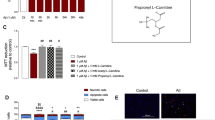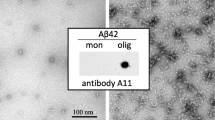Abstract
Acetyl-l-carnitine (ALCAR), normally produced in mitochondria, is a precursor of acetyl-CoA in the tricarboxylic (TCA) cycle. Since mitochondrial compromise and ATP depletion have been considered to play a role in neuronal degeneration in Alzheimer's disease (AD), we examined whether ALCAR attenuated oxidative stress and/or ATP depletion after exposure of cells to beta-amyloid (Abeta), a neurotoxic peptide that accumulates in AD brain. Differentiated SH-SY-5Y human neuroblastoma cells were exposed for 2–24 h to 20 μM Abeta in the presence and absence of 50 μM ALCAR. ALCAR attenuated oxidative stress and cell death induced by Abeta neurotoxicity. Abeta depleted ATP levels, suggesting Abeta may induce neurotoxicity in part by compromising neuronal energy. ALCAR prevented ATP depletion; therefore, ALCAR may mediate its protective effect by buffering oxidative stress and maintaining ATP levels.
Similar content being viewed by others
REFERENCES
Pettegrew, J. W., Levine, J., and McClure, R. J. 2000. Acetyl-L-carnitine physical-chemical, metabolic, and therapeutic properties: relevance for its mode of action in Alzheimer's disease and geriatric depression. Mol. Psychiatry. 5:616–632.
Gadaleta, M. N., Petruzzella, V., Renis, M., Fracasso, F., and Cantatore, P. 1990. Reduced transcription of mitochondrial DNA in the senescent rat.: Tissue dependence and effect of L-carnitine. Eur. J. Biochem. 187:501–506.
Hagen, T. M., Ingersoll, R. T., Wehr, C M., Lykkesfeldt, J., Vinarsky, V., Bartholomew, J. C., Song, M. H., and Ames, B. N. 1998. Acetyl-L-carnitine fed to old rats partially restores mitochondrial function and ambulatory activity. Proc. Natl. Acad. Sci. U.S.A. 95:9562–9566.
Paradies, G., Ruggiero, F. M., Petrosillo, G., Gadaleta, M. N., and Quagliariello, E. 1994. Effect of aging and acetyl-L-carnitine on the activity of cytochrome oxidase and adenine nucleotide translocase in rat heart mitochondria. FEBS Lett. 350:213–215.
Shigenaga, M. K., Hagen, T. M., and Ames, B. N. 1994. Oxidative damage and mitochondrial decay in aging. Proc. Natl. Acad. Sci. U.S.A. 91:10771–10778.
Brooks, J. O. 3rd, Yesavage, J. A., Carta, A., and Bravi, D. 1998. Acetyl L-carnitine slows decline in younger patients with Alzheimer's disease: A reanalysis of a double-blind, placebocontrolled study using the trilinear approach. Int. Psychogeriatr. 10:193–203.
Thal, L. J., Carta, A., Clarke, W. R., Ferris, S. H., Friedland, R. P., Petersen, R. C., Pettegrew, J. W., Pfeiffer, E., Raskind, M. A., Sano, M., Tuszynski, M. H., and Woolson, R. F. (1996) A 1–year multicenter placebo-controlled study of acetyl-L-carnitine in patients with Alzheimer's disease. Neurology 47:705–711.
Behl, C., Davis, J., Cole, G. M., and Schubert, D. 1992. Vitamin E protects nerve cells from amyloid beta protein toxicity. Biochem. Biophys. Res. Commun. 186:944–950.
Yankner, B. A., Duffy, L. K., and Kirshner, D. A. 1990. Neurotrophic and neurotoxic effects of amyloid b protein: Reversal by tachykinin neuropeptides. Science 250:279–282.
Ekinci, F. J., Malik, K. U., and Shea, T. B. 1999. Activation of the L voltage-sensitive calcium channel by mitogen-activated protein (MAP) kinase following exposure of neuronal cells to beta-amyloid.: MAP kinase mediates beta-amyloid-induced neurodegeneration. J. Biol. Chem. 274:30322–30327.
Kawahara, M. and Kuroda, Y. 2000. Molecular mechanism of neurodegeneration induced by Alzheimer's b-amyloid protein: Channel formation and disruption of calcium homeostasis. Brain Res. Bull. 53:389–397.
Mattson, M. P., Cheng, B., Davis, D., Bryant, K., Lieberburg, I., and Rydel, R. E. 1992. Beta-amyloid peptides destabilize calcium homeostasis and render human cortical neurons vulnerable to excitotoxicity. J. Neurosci. 12:376–389.
Ueda, K., Shinohara, S., Yagami, T., Asakura, K., and Kawasaki, K. 1997. Amyloid beta protein potentiates Ca2+ influx through L-type voltage-sensitive Ca2+ channels: A possible involvement of free radicals. J. Neurochem. 68:265–271.
Behl, C., Davis, J. B., Lesley, R., and Schubert, D. 1994. Hydrogen peroxide mediates amyloid beta protein toxicity. Cell 77:817–827.
Ekinci, F. J., Linsley, M. D., and Shea, T. B. 2000. Beta-amyloid-induced calcium influx induces apoptosis in culture by oxidative stress rather than tau phosphorylation. Brain Res. Mol. Brain Res. 76:389–395.
Hensley, K., Hall, N., Subramaniam, R., Cole, P., Harris, M., Aksenov, M., Aksenova, M., Gabbita, S. P., Wu, J. F., Carney, J. M., Lovell, M., Markesbery, W. R., and Butterfield, D. A. 1995. Brain regional correspondence between Alzheimer's disease histopathology and biomarkers of protein oxidation. J. Neurochem. 65:2146–2156.
Wallace, D. C. 1999. Mitochondrial diseases in man and mouse. Science 283:1482–1488.
Lambert, M. P., Stevens, G., Sabo, S., Barber, K., Wang, G., Wade, W., Krafft, G., Snyder, S., Holzman, T. F., and Klein, W. L. 1994. Beta/A4–evoked degeneration of differentiated SH-SY5Y human neuroblastoma cells. J. Neurosci. Res. 39: 377–385.
Shea, T. B. 1997. Phospholipids alter tau conformation, phosphorylation, proteolysis, and association with microtubules: Implication for tau function under normal and degenerative conditions. J. Neurosci. Res. 50:114–122.
Luo, Y., Bond, J. D., and Ingram, V. M. 1997. Compromised mitochondrial function leads to increased cytosolic calcium and to activation of MAP kinases. Proc. Natl. Acad. Sci. U.S.A. 94:9705–9710.
Ekinci, F. J. and Shea, T. B. 2000. Phosphorylation of tau alters its association with the plasma membrane. Cell Mol. Neurobiol. 20:497–508.
Sato, M., Matsuki, Y., Oguma, T., Tsujimoto, K., Takayama, E., and Tadakuma, T. 2000. Inhibition of glucocorticoid-induced apoptosis by the expression of antisense gene of mitochondrial ATPase subunit 6. FEBS Lett. 478:34–38.
Budd, S. L. and Nicholls, D. G. 1996. A reevaluation of the role of mitochondria in neuronal Ca2+ homeostasis. J. Neurochem. 66:403–411.
Capecchi, P. L., Laghi Pasini, F., Quartarolo, E., and Di Perri, T. 1997. Carnitines increase plasma levels of adenosine and ATP in humans. Vasc. Med. 2:77–81.
Dhitavat, S., Rivera, E. R., Rogers, E., and Shea, T. B. 2001. Differential efficacy of lipophilic and cytosolic antioxidants on generation of reactive oxygen species by amyloid-beta. J. Alzheimer's Dis. In press.
Aureli, T., Puccetti, C., Di Cocco, M. E., Arduini, A., Ricciolini, R., Scalibastri, M., Manetti, C., and Conti, F. 1999. Entry of [(1,2–13C2) acetyl]-L-carnitine in liver tricarboxylic acid cycle and lipogenesis: A study by 13C NMR spectroscopy in conscious, freely moving rats. Eur. J. Biochem. 263:287–293.
Beaver, J. P. and Waring, P. 1995. A decrease in intracellular glutathione concentration precedes the onset of apoptosis in murine thymocytes. Eur. J. Cell. Biol. 68:47–54.
Mark, R. J., Lovell, M. A., Markesbery, W. R., Uchida, K., and Mattson, M. P. (1997) A role for 4–hydroxynonenal, an aldehydic product of lipid peroxidation, in disruption of ion homeostasis and neuronal death induced by amyloid beta-peptide. J. Neurochem 68:255–264.
Hoshi, M., Takashima, A., Murayama, M., Yasutake, K., Yoshida, N., Ishiguro, K., Hoshino, T., and Imahori, K. 1997. Nontoxic amyloid beta peptide 1–42 suppresses acetylcholine synthesis: Possible role in cholinergic dysfunction in Alzheimer's disease. J. Biol. Chem. 272:2038–2041.
Kashiwaya, Y., Takeshima, T., Mori, N., Nakashima, K., Clarke, K., and Veech, R. L. 2000. D-beta-Hydroxybutyrate protects neurons in models of Alzheimer's and Parkinson's disease. Proc. Natl. Acad. Sci. U.S.A. 97:5440–5444.
Gray, C. W. and Patel, A. J. 1995. Neurodegeneration mediated by glutamate and beta-amyloid peptide: A comparison and possible interaction. Brain Res. 691:169–179.
Ho, P., Collins, S. C., Dhitavat, S., Ortiz, D., Ashline, D., Rogers, E., and Shea, T. B. 2001. Homocysteine potentiates beta-amyloid neurotoxicity: Role of oxidative stress. J. Neurochem. 78:24–25.
Ho, P., Ashline, D., Dhitavat, S., Ortiz, D., Collins, S. C., Rogers, E., and Shea, T. B. 2001. Folate deprivation induces neurodegeneration: Roles of oxidative stress and increased homocysteine. Mol. Biol. Cell In press.
Kruman, I. I., Culmsee, C., Chan, S., Kruman, Y., Guo, Z., Penix, L., and Mattson, M. P. 2000. Homocysteine elicits a DNA damage response in neurons that promotes apoptosis and hypersensitivity to excitotoxicity. J. Neurosci. 20:6920–6926.
Levitt, A. J. and Karlinsky, H. 1992. Folate, vitamin B12 and cognitive impairment in patients with Alzheimer's disease. Acta Psychiatr. Scand. 86:301–305.
McCaddon, A. and Kelly, C. L. 1992. Familial Alzheimer's disease and vitamin B12 deficiency. Age Ageing 23:334–337.
Miller, J. W. 2000. Homocysteine, Alzheimer's disease and cognitive function. Nutrition 16:675–677.
White, A. R., Huang, X., Jobling, M. F., Barrow, C. H., Beyreuther, K., Masters, C. L., Bush, A. I., and Cappai, R. 2001. Homocysteine potentiates copper-and amyloid beta peptide-mediated toxicity in primary cultures: Possible risk factors in the Alzheimer's-type neurodegenerative pathways. J. Neurochem. 76:1509–1520.
Author information
Authors and Affiliations
Rights and permissions
About this article
Cite this article
Dhitavat, S., Ortiz, D., Shea, T.B. et al. Acetyl-l-Carnitine Protects Against Amyloid-Beta Neurotoxicity: Roles of Oxidative Buffering and ATP Levels. Neurochem Res 27, 501–505 (2002). https://doi.org/10.1023/A:1019800703683
Issue Date:
DOI: https://doi.org/10.1023/A:1019800703683




